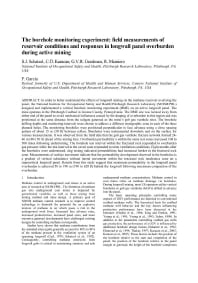Mining Publication: The Borehole Monitoring Experiment: Field Measurements of Reservoir Conditions and Responses in Longwall Panel Overburden During Active Mining
Original creation date: June 2008
Authors: SJ Schatzel, C� Karacan, GV Goodman, RJ Mainiero, F Garcia
NIOSHTIC2 Number: 20034033
Proceedings of the 12th U.S./North American Mine Ventilation Symposium, Reno, Nevada, June 9-11, 2008. Wallace, Jr. KG. ed., Reno, NV: University of Nevada - Reno, 2008; :93-101
In order to better understand the effects of longwall mining on the methane reservoir overlying the panel, the National Institute for Occupational Safety and Health/Pittsburgh Research Laboratory (NIOSH/PRL) designed and implemented a vertical borehole monitoring experiment (BME) on an active longwall panel. The mine operates in the Pittsburgh Coalbed in Greene County. Pennsylvania. The BME site was located away from either end of the panel to avoid mechanical influences caused by the draping of overburden in this region and was positioned at the same distance from the tailgate gateroad as the mine's gob gas venthole sites. The borehole drilling depths and monitoring intervals were chosen to address a different stratigraphic zone in each of the three planned holes. The monitoring boreholes were positioned perpendicular to face advance using a close spacing pattern of about 15 m (50 ft) between collars. Boreholes were instrumented downhole and on the surface for various measurements. It was observed from the field data that the gob gas venthole fracture network formed 24-46 m (80-150 ft) ahead of the mining face. Overburden permeability's within the same test zones increased 100 to 500 times following undermining. The borehole test interval within the fractured rock responded to overburden gas pressure while the test interval in the caved zone responded to mine ventilation conditions. Eight months after the boreholes were undermined, slug testing indicated permeabilities had increased further in the fractured rock zone. Measurements of surface movement indicate that the permeability development observed in the boreholes is a product of vertical subsidence without lateral movement within the tensional rock mechanics zone on a supercritical longwall panel. Results from this study suggest that maximum permeability in the longwall panel overburden is achieved 58 to 190 m (190 to 620 ft) behind the longwall following maximum compaction of the overburden.

NIOSHTIC2 Number: 20034033
Proceedings of the 12th U.S./North American Mine Ventilation Symposium, Reno, Nevada, June 9-11, 2008. Wallace, Jr. KG. ed., Reno, NV: University of Nevada - Reno, 2008; :93-101
- Comparisons Between Cross-Measure Boreholes and Surface Gob Holes
- Effect of a Surface Borehole on Longwall Gob Degasification (Pocahontas No. 3 Coalbed)
- Guidelines for the Prediction and Control of Methane Emissions on Longwalls
- Longwall Gob Degasification With Surface Ventilation Boreholes Above the Lower Kittanning Coalbed
- Methane Control on Longwalls with Cross-Measure Boreholes (Lower Kittanning Coalbed)
- Modeling and Prediction of Ventilation Methane Emissions of U.S. Longwall Mines Using Supervised Artificial Neural Networks
- Numerical Analysis of the Influence of In-Seam Horizontal Methane Drainage Boreholes on Longwall Face Emission Rates
- Predicting Methane Emissions from Longer Longwall Faces by Analysis of Emission Contributors
- Prediction of Longwall Methane Emissions and the Associated Consequences of Increasing Longwall Face Lengths: A Case Study in the Pittsburgh Coalbed
- Remote Methane Sensors